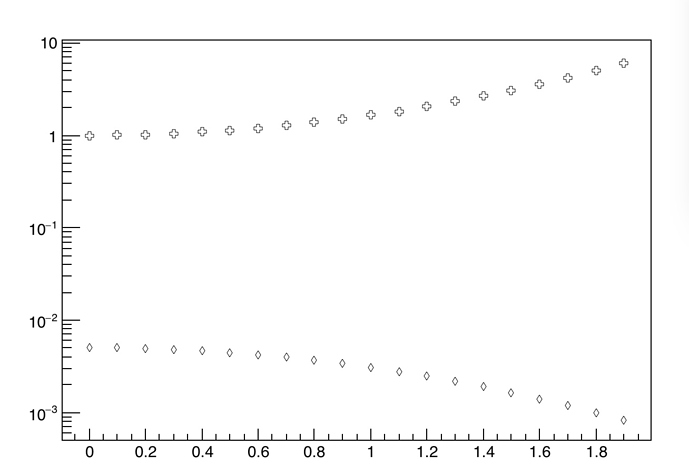how do you plot two sets of data points with the same x-range (same values) but with different y-range? For example: {(0,5); (1,7); (2,10); (3,15)} and {(0,1000); (1,2000); (2,10000); (3,1500000)}. Thanks for your help.
import numpy as np
import ROOT
x = np.array([0,1,2,3], dtype='float64')
y1 = np.array([5,7,10,15], dtype='float64')
y2 = np.array([1000,2000,10000,1500000], dtype='float64')
g1 = ROOT.TGraph(len(x), x, y1)
g2 = ROOT.TGraph(len(x), x, y2)
mg = ROOT.TMultiGraph()
mg.Add(g1)
mg.Add(g2)
mg.Draw("AP")
thanks ksmith  i will try to figure it out… i am actually doing two for-loops that give out two different values for the same x
i will try to figure it out… i am actually doing two for-loops that give out two different values for the same x 
it has this error:
error: no member named
’TMultiGraph’ in namespace 'ROOT’
mg = ROOT::TMultiGraph()
What language are you using? Can you post a small example?
My example from above converted to C++
#include<array>
#include <TGraph.h>
#include <TMultiGraph.h>
{
std::array<Int_t, 4> x = {0,1,2,3};
std::array<Int_t, 4> yData1 = {5,7,10,15};
std::array<Int_t, 4> yData2 = {1000,2000,10000,1500000};
auto g1 = new TGraph(4, x.data(), yData1.data());
auto g2 = new TGraph(4, x.data(), yData2.data());
auto mg = new TMultiGraph();
mg->Add(g1);
mg->Add(g2);
mg->Draw("AP");
}
#include "TF1.h"
#include "Math/WrappedTF1.h"
#include "Math/GaussIntegrator.h"
void program002rootforum()
{
int N = 20;
double a = 0.5;
double m = 1.0;
double E = 0.5;
double s = 1.0;
double p = m / (2.0*a);
double q = m / a;
double xi = 0.0;
double r = m / (2.0*a);
double w = a / 2.0;
double u = m / (2.0*a);
double v = m / a;
double xf = 2.0;
double xd = (xf-xi) / N;
g = new TGraph();
g1 = new TGraph();
for(i=0; i<N; i++)
{
double x, y;
x = xd * i;
y = exp(x*x/2.0);
g -> SetPoint (i, x, y);
g -> SetMarkerStyle(28);
}
for(i=0; i<N; i++)
{
double x, y;
x = xd * i;
y = exp(-x*x/2.0) / (sqrt(sqrt(TMath::Pi())))*exp(-E*a*N);
g1 -> SetPoint (i, x, y);
g1 -> SetMarkerStyle(28);
}
mg = ROOT::TMultiGraph();
mg.Add(g);
mg.Add(g1);
mg.Draw("AP");
}
#include <TGraph.h>
#include <TMultiGraph.h>
//...
auto mg = new TMultiGraph();
mg->Add(g);
mg->Add(g1);
mg->Draw("AP");
//...
FYI:
thanks very much 
your fyi is noted… i’m sorry…
It worked!!!
But there is another catch.
The y-values of “g1” are nearly visible because they are very small.
It makes only a horizontal line at the bottom.
The other graph is visible because its y-values are really large.
How do I scale the y-values of “g1” to make both graphs visible? 
No worries, you’ll get better response with eay to read posts.
Maybe log-axis?
gPad->SetLogy()
Or scale one of the sets of y-values:
scale = 1000;
y = exp(x*x/2.0) * scale;
thanks… i tried the “scale” 
yes, tried it… but thanks 
void program002rootforum()
{
int N = 20;
double a = 0.5;
double m = 1.0;
double E = 0.5;
double s = 1.0;
double p = m / (2.0*a);
double q = m / a;
double xi = 0.0;
double r = m / (2.0*a);
double w = a / 2.0;
double u = m / (2.0*a);
double v = m / a;
double xf = 2.0;
double xd = (xf-xi) / N;
TGraph *g = new TGraph();
TGraph *g1 = new TGraph();
double x, y;
int i;
g->SetMarkerStyle(28);
for (i=0; i<N; i++) {
x = xd * i;
y = exp(x*x/2.0);
g->SetPoint (i, x, y);
}
g1 -> SetMarkerStyle(27);
for (i=0; i<N; i++) {
x = xd * i;
y = exp(-x*x/2.0) / (sqrt(sqrt(TMath::Pi())))*exp(-E*a*N);
g1 -> SetPoint (i, x, y);
}
TMultiGraph *mg = new TMultiGraph();
mg->SetMinimum(0.0005);
mg->Add(g);
mg->Add(g1);
mg->Draw("AP");
gPad->SetLogy(1);
}
This topic was automatically closed 14 days after the last reply. New replies are no longer allowed.
